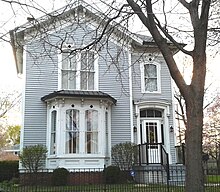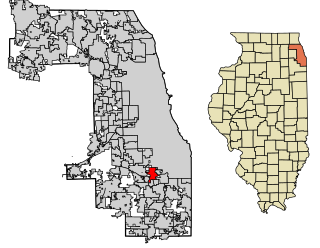
Blue Island is a city and a south suburb of Chicago in Cook County, Illinois, located approximately 16 miles (26 km) south of Chicago's Loop. Blue Island is adjacent to the city of Chicago and shares its northern boundary with that city's Morgan Park neighborhood. The population was 23,706 at the 2010 United States Census.
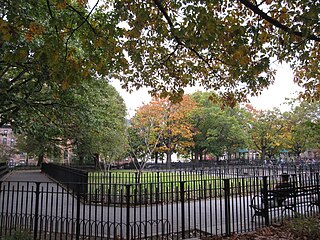
Clinton Hill is a neighborhood in north-central Brooklyn, a borough of New York City. It is bordered by the Brooklyn Navy Yard and the Brooklyn-Queens Expressway to the north, Williamsburg to the northeast, Classon Avenue and Bedford–Stuyvesant to the east, Atlantic Avenue and Prospect Heights to the south and southwest and Vanderbilt Avenue and Fort Greene to the west.

Michigan Avenue is a north-south street in Chicago which runs at 100 east on the Chicago grid. The northern end of the street is at Lake Shore Drive on the shore of Lake Michigan in the Gold Coast Historic District. The street's southern terminus is at Sibley Boulevard in the southern suburb of Harvey, though like many Chicago streets it exists in several disjointed segments.

Streeterville is a neighborhood in the Near North Side community area of Chicago, Illinois, United States, north of the Chicago River. It is bounded by the river on the south, the Magnificent Mile portion of Michigan Avenue on the west, and Lake Michigan on the north and east, according to most sources, although the City of Chicago only recognizes a small portion of this region as Streeterville. Thus, it can be described as the Magnificent Mile plus all land east of it. The tourist attraction of Navy Pier extends out into the lake from southern Streeterville. The majority of the land in this neighborhood is reclaimed sandbar.

The Auditorium Building in Chicago is one of the best-known designs of Louis Sullivan and Dankmar Adler. Completed in 1889, the building is located at the northwest corner of South Michigan Avenue and Congress Street. The building, which when constructed was the largest in the United States and the tallest in Chicago, was designed to be a multi-use complex, including offices, a theater, and a hotel. As a young apprentice, Frank Lloyd Wright worked on some of the interior design.
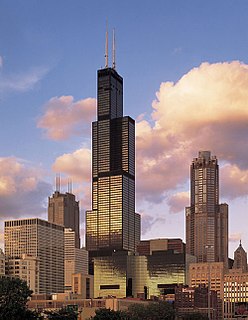
The buildings and architecture of Chicago have influenced and reflected the history of American architecture. The built environment of Chicago is reflective of the city's history and multicultural heritage, featuring prominent buildings in a variety of styles by many important architects. Since most structures within the downtown area were destroyed by the Great Chicago Fire in 1871 Chicago buildings are noted for their originality rather than their antiquity.

Logan Square is an official community area, historical neighborhood, and public square located on the northwest side of the City of Chicago. The Logan Square community area is one of the 77 city-designated community areas established for planning purposes. The Logan Square neighborhood, located within the Logan Square community area, is centered on the public square that serves as its namesake, located at the three-way intersection of Milwaukee Avenue, Logan Boulevard and Kedzie Boulevard.

Irving Park is one of 77 officially designated Chicago community areas located on the Northwest Side. It is bounded by the Chicago River on the east, the Milwaukee Road railroad tracks on the west, Addison Street on the south and Montrose Avenue on the north, west of Pulaski Road stretching to encompass the region between Belmont Avenue on the south and, roughly, Leland Avenue on the north. It is named after the American author Washington Irving.

Morgan Park, located on the far south side of the city of Chicago, Illinois, United States, is one of the city's 77 official community areas. Morgan Park is located south of the Beverly neighborhood and north of the Chicago city border, and includes Mount Greenwood Cemetery. The community, settled in the mid-19th century, was initially known as North Blue Island, being located close to the existing town of Blue Island to the south. As of 2013, Morgan Park was majority-black, with approximately 22,924 residents in 2015.

Abell is a neighborhood located in the north-central area of Baltimore, Maryland, United States. It is considered to be part of Charles Village, Baltimore.
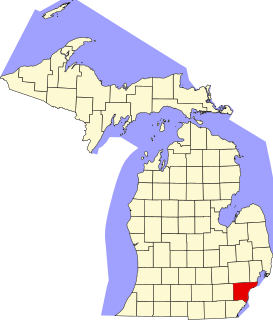
This is a list of the National Register of Historic Places listings in Wayne County, Michigan.

Grace Church is a historic parish church in Manhattan, New York City which is part of the Episcopal Diocese of New York. The church is located at 800-804 Broadway, at the corner of East 10th Street, where Broadway bends to the south-southeast, bringing it in alignment with the avenues in Manhattan's grid. Grace Church School and the church houses – which are now used by the school – are located to the east at 86-98 Fourth Avenue between East 10th and 12th Streets.

The John J. Glessner House, operated as the Glessner House, is an architecturally important 19th-century residence located at 1800 S. Prairie Avenue, Chicago, Illinois. It was designed in 1885–1886 by architect Henry Hobson Richardson and completed in late 1887. The property was designated a Chicago Landmark on October 14, 1970. The site was listed in the National Register of Historic Places on April 17, 1970, and as a National Historic Landmark on January 7, 1976.

Stuyvesant Square is the name of both a park and its surrounding neighborhood in the New York City borough of Manhattan. The park is located between 15th Street, 17th Street, Rutherford Place, and Nathan D. Perlman Place. Second Avenue divides the park into two halves, east and west, and each half is surrounded by the original cast-iron fence.

The Henry B. Clarke House is a Greek Revival style house in Chicago, Illinois, United States. Henry Brown Clarke was a native of New York State who had come to Chicago in 1833 with his wife, Caroline Palmer Clarke, and his family. He entered into the hardware business with William Jones and Byram King, establishing King, Jones and Company, and provided building materials to the growing Chicago populace. The house was built in circa 1836 by a local contractor, probably John Rye, who later married the Clarkes' housemaid, Betsy.
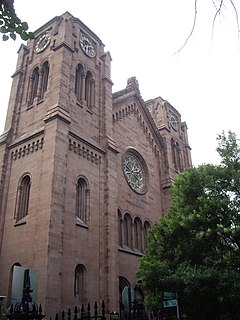
St. George's Episcopal Church is a historic church located at 209 East 16th Street at Rutherford Place, on Stuyvesant Square in Manhattan, New York City. Called "one of the first and most significant examples of Early Romanesque Revival church architecture in America", the church exterior was designed by Charles Otto Blesch and the interior by Leopold Eidlitz. It is one of the two sanctuaries of the Calvary-St. George's Parish.

Robert Henderson Robertson was an American architect who designed numerous houses, institutional buildings and churches.

This is a list of the National Register of Historic Places listings in Detroit, Michigan.

Longfellow, Alden & Harlow, of Boston, Massachusetts, and Pittsburgh, Pennsylvania, was the architectural firm of Alexander Wadsworth Longfellow, Jr. (1854–1934), Frank Ellis Alden (1859–1908), and Alfred Branch Harlow (1857–1927). The firm, successors to H. H. Richardson, continued to provide structures in the Romanesque revival style established by Richardson that is often referred to as Richardsonian Romanesque.

The architecture of Jacksonville is a combination of historic and modern styles reflecting the city's early position as a regional center of business. According to the National Trust for Historic Preservation, there are more buildings built before 1967 in Jacksonville than any other city in Florida, but it is also important to note that few structures in the city center predate the Great Fire of 1901. Numerous buildings in the city have held state height records, dating as far back as 1902, and last holding a record in 1981.
